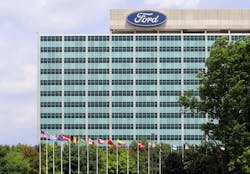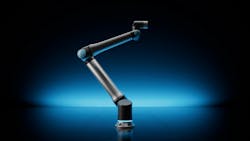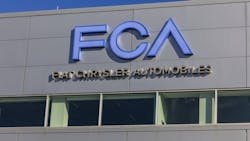Ford Saves Itself and Cobots Get Real: 25 in 2025
Where were you in 2004? If you’re Gen Z, maybe you didn’t even exist yet, let alone know what was happening in the world that affected manufacturing.
In our second installment of Manufacturing Gamechangers: 25 in 2025, we look at the people, policy, technology, events and trends that shaped the years 2004 to 2009. Several are tied to the Great Recession, which had a long tail in the US and world economy, and the housing crash that led up to it. But even in an economic downturn, ingenuity and innovation managed to thrive.
Special thanks to IndustryWeek contributors Jamie Flinchbaugh, Christopher Tang, Carolyn Hendrickson, Warren Browne and Lauren Pittelli and former IndustryWeek editors Pat Panchak and Travis Hessman, who all gave us valuable input on the list.
We’d like to hear from our readers as well. Do you have a gamechanger that’s not on the list—or have your own unique list in mind? Or, maybe you just want to relate a memory associated with one of our Gamechangers. Please share with us below.
#6: Ford Saves Itself
Ford Motor Co. was barreling toward bankruptcy in 2004 after years of mismanagement. The company had a top-down structure short on accountability, divisions were siloed, and Ford engineers were proprietary about the technology they developed to the point that they refused to share with colleagues in other locations.
To stem the bleeding, Bill Ford, great-grandson of founder Henry, took over as CEO and paved the way for restructuring. He closed five factories, cut 21,000 jobs and curtailed lavish executive spending accounts.
After setting ambitious cost-cutting goals, Bill Ford stepped down as CEO in 2006 and replaced himself with Alan Mulally, a Boeing executive who had just been passed over for the CEO role there.
When he arrived at Ford, Mulally announced his plan to mortgage all company assets, raising $23.5 billion in private loans with good terms, before the economy tanked in 2008. He downsized Ford’s dealership network, closed idle factories sold Volvo, Land Rover and Jaguar, and ended the Mercury brand.
To change the culture, he streamlined the command structure to make leadership more accountable for performance. He emphasized consistency of vision and respect for people and put facts over favoritism, drilling down for data in meetings.
During the Great Recession, Ford stayed solvent while General Motors and Chrysler went through government-funded bankruptcies. By 2010, Ford was out of the woods and profitable. Mulally retired in 2014, but his emulated leadership style helped nudge manufacturing out of its outdated hierarchical rut and into a new, more relevant era.—Laura Putre
More Manufacturing Gamechangers
#7: Millennials Enter the Workforce—and Change Things up
Born between 1981 and 1996, millennials are the largest generation in U.S. history, and their coming of age had a similarly large impact on the workplace. As a group, they were known to value corporate responsibility and adherence to ethical practices more than previous generations, seeing their workplace as an extension of their own morals.
Companies shifted their recruiting strategies accordingly, highlighting their values and honing their missions to incorporate sustainability and caring for community. Manufacturers that were technology-savvy and up-to-date on the latest equipment also had an edge with millennials, who had grown up during the rise of the internet and expected to use technology in their everyday lives.
An emphasis on a college education as millennials grew up most likely skewed their view of the manufacturing industry, making it a less desirable career path and requiring manufacturers to work harder to recruit and train them. With high school vocational programs dismantled, manufacturers who worked to build relationships with high schools and training programs to develop talent were better-placed to fill needed roles and transfer knowledge to a new generation.—Anna Smith
#8: Cobots Become a Realistic Option for Manufacturers
Prior to 2008, the idea of industrial robotics mostly evoked images of giant robot arms locked behind safety cages. Then Danish company Universal Robots introduced the model UR5 cobot arm, originally deployed to automate CNC machine tending.
Linatex, the Danish industrial plastics and rubber supplier to whom Universal Robots sold the first cobot, put the UR5 right next to their operators and used a touch screen to program movement.
Now, Universal Robots should not be credited with inventing the cobot. The concept goes back to the mid-1990s and early machines developed at Northwestern University, where the word “cobot” was also coined.
However, the UR5 made waves for just how closely it could work with human operators. Gone were the giant cages and fear of being swatted halfway across the shop floor by an errant sweep of a gigantic robot arm.
Also gone was the perception that robots were only the purview of large manufacturers with large CapEx funds. Thanks to the rise of the cobot, now even smaller manufacturers could afford robotic automation.—Dennis Scimeca
#9: Manufacturing Is Never the Same After the Great Recession
In 2008, subprime loans precipitated a crash in the housing market, the first domino to fall in the worst recession in more than 70 years. The ensuing bankruptcies and bailouts sent the U.S. economy spiraling into the Great Recession, which lasted until 2010 with a slow recovery that followed.
U.S. manufacturing got walloped. The sector lost 20% of its output and 15% of its workforce. Capacity utilization fell 8 percentage points. More than one-quarter (26%) of the 8.7 million jobs lost during the recession were in manufacturing.
Companies moved entire areas of manufacturing offshore. Semiconductor manufacturers shifted production of silicon wafers to contractors overseas. There were 36% fewer tool-and-die shops post Great Recession. Small shops with thin profit margins couldn’t make payroll or keep the machines running. Apprenticeship programs were among the first line items cut when budgets got tight.
The manufacturing economy bottomed out in mid-2009, and by the end of that year, manufacturing was recovering faster than the overall economy. “It was helping to pull the overall economy out of the bottom of the Great Recession,” noted then-MAPI Foundation Chief Economist Cliff Waldman.
But quick gains just as quickly dried up. Global currency issues and problems in China slowed U.S. manufacturing growth. By 2017, manufacturing production was still 6.7% below its December 2007 peak.—Laura Putre
#10: The US Government Bails Out the Auto Industry
GM lost $40 billion in 2007 and $31 billion in 2008, and Chrysler lost $39.3 billion in 2008. The 2008 market crash closed the credit market to the indebted automakers.
Sales of passenger cars and light trucks in the U.S. dropped from 16.2 million in 2007 to 13.5 million in 2008, then to 10.1 million in 2009. Together, the Detroit 3 automakers had 15 assembly plants idling and 25,000 UAW workers laid off.
President George W. Bush in late 2008 extended some credit to GM and Chrysler after Congress refused a bailout package. President Barack Obama in Feb. 2009 appointed a task force that found GM and Chrysler’s restructuring plans were not viable.
The government ultimately put forth $82 billion in taxpayer money to bail out the two auto companies and forced them into bankruptcy. Obama-era officials fired GM’s leadership and arranged the sale of Chrysler to Italy’s Fiat.
Despite public criticism, the bailout ultimately saved the automakers and the U.S. auto industry and the jobs tied to it (though UAW workers lost some retirement benefits and had to commit to a lower wage tier for new hires).
And it saved the supply chain. Without GM and Chrysler, many automotive suppliers would not have survived, even if the remaining pool of auto manufacturers could give them new business.—Laura Putre
About the Author
Jill Jusko
Bio: Jill Jusko is executive editor for IndustryWeek. She has been writing about manufacturing operations leadership for more than 20 years. Her coverage spotlights companies that are in pursuit of world-class results in quality, productivity, cost and other benchmarks by implementing the latest continuous improvement and lean/Six-Sigma strategies. Jill also coordinates IndustryWeek’s Best Plants Awards Program, which annually salutes the leading manufacturing facilities in North America.
Have a story idea? Send it to [email protected].

Laura Putre
Senior Editor, IndustryWeek
As senior editor, Laura Putre works with IndustryWeek's editorial contributors and reports on leadership and the automotive industry as they relate to manufacturing. She joined IndustryWeek in 2015 as a staff writer covering workforce issues.
Prior to IndustryWeek, Laura reported on the healthcare industry and covered local news. She was the editor of the Chicago Journal and a staff writer for Cleveland Scene. Her national bylines include The Guardian, Slate, Pacific-Standard and The Root.
Laura was a National Press Foundation fellow in 2022.
Got a story idea? Reach out to Laura at [email protected]
Dennis Scimeca
Dennis Scimeca is a veteran technology journalist with particular experience in vision system technology, machine learning/artificial intelligence, and augmented/mixed/virtual reality (XR), with bylines in consumer, developer, and B2B outlets.
At IndustryWeek, he covers the competitive advantages gained by manufacturers that deploy proven technologies. If you would like to share your story with IndustryWeek, please contact Dennis at [email protected].
Ryan Secard
Associate Editor
Ryan Secard joined Endeavor B2B in 2020 as a news editor for IndustryWeek. He currently contributes to IW, American Machinist, Foundry Management & Technology, and Plant Services on breaking manufacturing news, new products, plant openings and closures, and labor issues in manufacturing.
Anna Smith
News Editor
News Editor
LinkedIn: https://www.linkedin.com/in/anna-m-smith/
Bio: Anna Smith joined IndustryWeek in 2021. She handles IW’s daily newsletters and breaking news of interest to the manufacturing industry. Anna was previously an editorial assistant at New Equipment Digest, Material Handling & Logistics and other publications.








